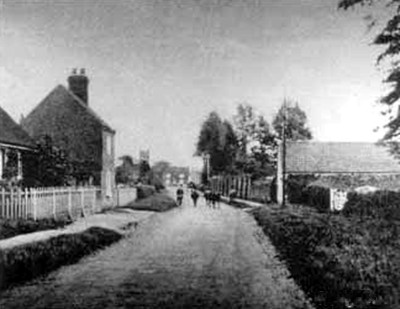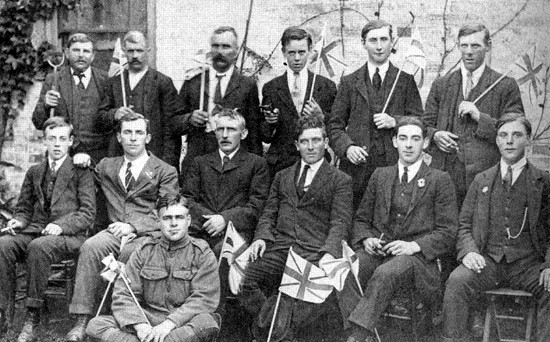|
Ran-tanning - punishment
by the mob

Sexual or other misconduct may be
the cause of idle or malicious gossip among the neighbours but there the
matter usually ends. Not so in past times when the culprits, especially if
they lived in villages or small communities, were likely to be the victims
of ran-tanning, a particularly nasty form of social punishment prevalent
in this part of the Lincolnshire fens until the early years of the last
century.
Ran-tanning was a notorious method of expressing public indignation
whenever someone transgressed the bounds of what was perceived to be good
behaviour but as with all illegal gatherings the definition was usually
confined to that laid down by the ringleaders and often closely resembled
a riot.
If someone had committed some act of which the other villagers
disapproved, they would congregate near their house and make a terrible
commotion by beating with sticks, tins, cans, pots, pans, buckets and
kettles, playing mouth organs, booing, shouting and singing and on
occasions lighting bonfires. The demonstrations were carried on for a
number of nights in succession, usually three, after which an effigy of
the person who had incurred their displeasure would be burned in a nearby
field.
This was a form of vigilantism likely to provoke
social disorder, doled out to anyone who breached the local code of what
was right and what was wrong and was particularly likely in the case of
sexual misdemeanours including adultery and domestic incidents such as wife
beating.
One of the earliest reported cases in
Lincolnshire was in 1878 when four farm labourers were brought before the
magistrates at Boston. The court was told that they had been arrested at
Fosdyke on November 23rd for riotous and drunken behaviour while
celebrating the custom of ran-tanning a village worthy who had thrashed
his wife and having taken more beer than was good for them they were taken
into custody. They were fined five shillings each.
The following January there was a similar case before Horncastle
magistrates when eleven men were given small fines for causing an
obstruction in the market place at Tattershall and refusing to move when
ordered to do so by the police. The court was told that the village had
been in uproar with sixty or more men ran-tanning a woman who had
ill-treated her servant girl by banging pots and pans, sounding horns and
even firing a pistol.
In the summer of 1879, a woman, Sarah
Hodson, of New Quarrington, near Sleaford, was persecuted with ran-tanning
by villagers for three consecutive nights although we are not told of her
offence but as a result the windows of her house were broken and she was
physically assaulted. As a result, eight men appeared before the
magistrates and were fined 10s. each and ordered to pay the cost of
replacing them.
In fact, cases became so frequent and so serious during the late
19th century that they eventually attracted the attention of the
authorities and ran-tanning was banned under the Highways Act
of 1882.
Yet offences persisted. Illicit sexual liaisons were particularly prevalent
in this country during the Great War of 1914-18 when husbands had either
volunteered or been conscripted into the army to fight in the trenches of
Flanders and France leaving wives behind who were vulnerable to temptation
although always wary of what the neighbours might say.
Not all of the soldiers were sent home immediately after the Armistice and
by the following summer, hundreds had still not been reunited with their
loved ones and in 1919, a case came before the magistrates at the Town
Hall in Bourne when it was alleged that a woman and her lover had been
ran-tanned by a group of men at Rippingale on August 29th on the grounds
that she had been carrying on with a sergeant-major on leave while her
husband was still away from home serving with the army.
Eight men were summoned to appear for unlawfully joining in a brawl and
the case created so much interest that the courtroom was crowded with
villagers for the entire two-hour hearing when the police described how
they had been called out to quell a riot in which a crowd of men were
causing pandemonium outside a house by beating drums, tins, buckets,
plough shares, old pieces of iron and playing instruments, shouting and
yelling, later gathering in a nearby field where two effigies were burned.
The disturbances continued for three nights by which time the entire
village was in a state of commotion and the noise could be heard two miles
away but the men ignored all entreaties to stop despite warnings that they
were guilty of disorderly conduct.
Solicitor Cecil Crust, who appeared for the defendants, argued that the
men were not guilty of a brawl and quoted the dictionary definition as “a
noisy quarrel” and whilst he admitted that there had been some noise,
insisted that the men were not quarrelling. His argument was overruled by
the magistrates and Superintendent Herbert Bailey, head of the Bourne
police, told the bench: “The conduct of these men was disgraceful and it
is abominable that people should be subjected to such rowdyism.”
After some discussion, the magistrates
agreed to the charges being withdrawn provided the defendants expressed
regret for their actions and undertook not to repeat such incidents under
any circumstances in the future although they were ordered to pay costs.
Ran-tanning was by then dying out and the last recorded case in South
Lincolnshire was at Quadring Fen, near Spalding on 15th February 1928 when
the victim was a woman alleged to have made remarks scandalising her
neighbours. Police intervened and 23 people were charged with disorderly
conduct when the court was told that ran-tanning was perhaps the only
survival of mob law that still existed in this country. All of the defendants
were fined between five and ten shillings and ordered to pay costs and
there have been no further cases of this nature since.
|
 |
|
THE RIPPINGALE RAN-TAN GANG
The thirteen accused men in the court case of
1919 who unashamedly posed for this photograph, calling themselves
the Rippingale Jazz Band. They were left to right (back row) J
Vickers, E Stubley, J Parson, H Scarborough, N Sandall and A
Thompson; second row J Scarborough, A Herriman, F Newcomb, H Sandall,
J Williamson and F Martin; in uniform Private W Fullman. |
Return to
Rippingale

Go to:
Main Index Villages
Index
|
